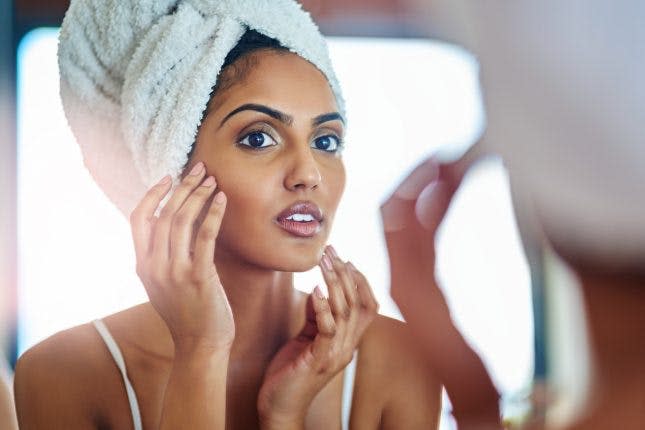Period Acne Is Real, and This Is Why
Getting your period can ruin more than just your favorite pair of underwear — it can mess up your sleeping patterns, drain your energy, and even ruin your chances at clear skin. Just ask Chrissy Teigen, who recently ranted about the woes of “period skin” on Snapchat. Instead of giving in to our unruly skin during shark week, we’re educating ourselves on why our periods are messing up our skin by enlisting Nicole Telfer, a science content producer and writer for female health app Clue, to teach us how our cycle is tampering with our complexion.

1. If you have naturally oily skin, you’re probably going to be extra oily before and during your period. If you’re the type of lady who’s always reaching for blotting paper, getting your period can actually enhance oil production in your face. “Many of the skin changes you may experience around puberty and later in life are due to small glands called sebaceous glands,” says Telfer. “These sebaceous glands produce and secrete an oily substance called sebum.” What’s interesting is that these glands are dramatically affected by androgens (they’re basically male sex hormones that are present in both sexes). “When there are more androgens binding to the receptors on the sebaceous glands, more sebum is produced.” In one study of women with naturally oily skin, researchers found a significant increase in sebum production during the week preceding and the week of menstruation.
2. If you don’t have naturally oily skin, your period isn’t going to make your face oilier. If you have a naturally dry or normal skin type, you probably don’t have to worry about being extra oily during your period. In the same study mentioned above, women without an oily skin type showed no significant changes in sebum production.
3. There’s a good chance you may experience sensitive skin during menstruation. “One study found that two out of five women self-report more sensitive skin around the time of menstruation, which researchers suspect could be due to low levels of estrogen during this phase,” notes Telfer. While it’s still unclear how much estrogen directly effects sebaceous glands, it’s clear that estrogen plays a prominent role in overall skin health and that almost half of women deal with some sort of sensitive skin issue during menstruation.
4. Period acne is REAL, and it’s most common during the perimenstrual phase. It’s not surprising that acne is one of the most frequently reported skin ailments connected to our menstrual cycles. “When high levels of androgens promote excess sebum production, the sebum can combine with dead skin cells from within the pore, causing a blockage,” says Telfer. “This blockage of the pore can trap all the excess sebum being produced and manifest as acne. These sebum-filled pores are the ideal place for bacteria to live — particularly P. acnes, which loves to colonize these pores, and further worsen and cause inflammatory acne.” Keep in mind that period-related hormonal breakouts are particularly common during the perimenstrual phase (AKA the 10 days before your period and the days that you’re actually bleeding) and plan your skincare strategy accordingly.
5. Women with polycystic ovarian syndrome (PCOS) and trans men are more likely to experience menstrual acne. Unfortunately, there are a few people who simply have a higher probability of developing menstrual-related acne. “Women and people with cycles who have higher levels of androgens, such as people with PCOS, are more likely to have acne, as well as excess hair growth and female pattern hair loss,” says Telfer. “Transgender men may also notice an increase in acne lesions during the first year of taking testosterone, but this should decrease after long-term testosterone use.”
6. Hormonal birth control can result in a reduction of acne breakouts. Okay, so we know why period acne occurs, but what are some of the ways we can reduce breakouts? One way is by using hormonal birth control. “Some people see a reduction in acne breakouts on hormonal birth control, which is why oral contraceptives are sometimes used to treat acne. Within the combined contraceptive pill, synthetic estrogen is present in doses that suppress ovulation. When ovulation doesn’t occur, ovarian androgens are not produced.” Just remember to discuss with your doctor what you really want out of your birth control (it’s totally okay to say you want something to treat acne!) before making a decision.
7. Sweating more is inevitable during the second half of your cycle. Raise your hand if you’re a naturally sweaty lady! Turns out, during certain parts of your cycle (specifically the second half, or luteal phase), you’re likely to sweat more than usual. This is because your basal body temperature increases during the luteal phase. “Researchers have noticed that women in their luteal phase show an increase in sweat produced when exposed to warmer temperatures, in comparison to when they were in their follicular phase (the first half of their menstrual cycle). This increase in sweating was noticed not just on the face, but across the whole body.”
8. Dermatitis, psoriasis, and other skin conditions or diseases may worsen during the premenstrual phase. There are a ton of factors that contribute to having dry skin, including being in a cold climate or simply aging (dry skin is more prevalent with age). That being said, “Dermatitis, psoriasis, and other skin conditions or diseases may worsen during the premenstrual phase,” says Telfer. “Your skin may change in response to hormonal variations occurring throughout your cycle.” Because there could be many factors contributing to these skin conditions, make sure to keep track of your skin changes along with other life factors like sleep and stress to make it easier to notice new patterns.
How does your period affect your skin? Tweet us by mentioning @BritandCo.
(Photo via Getty)


